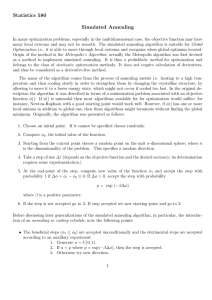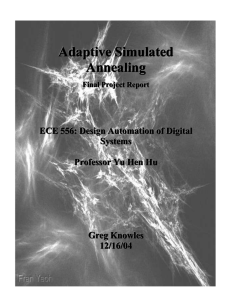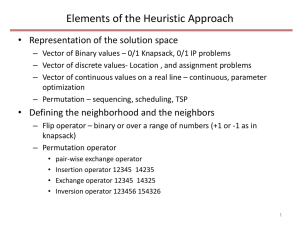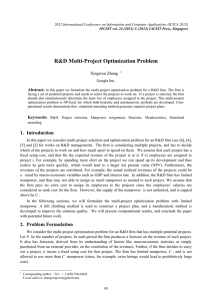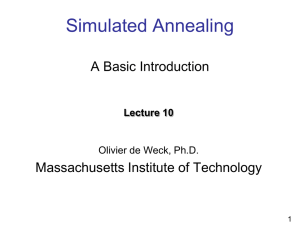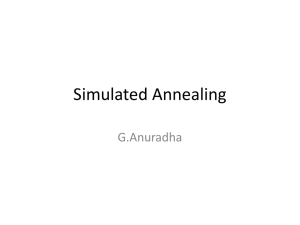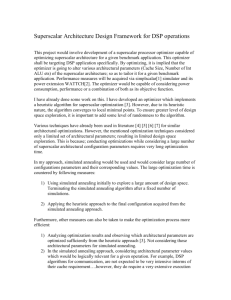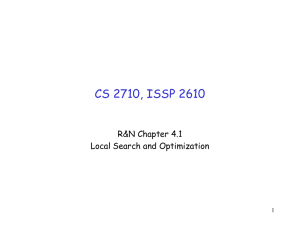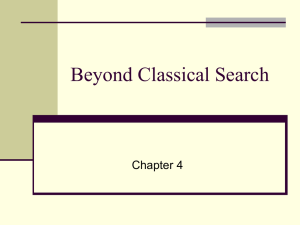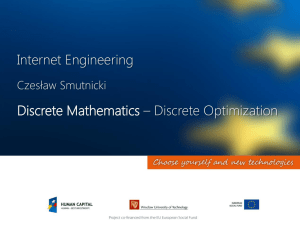Simulated Annealing (SA)
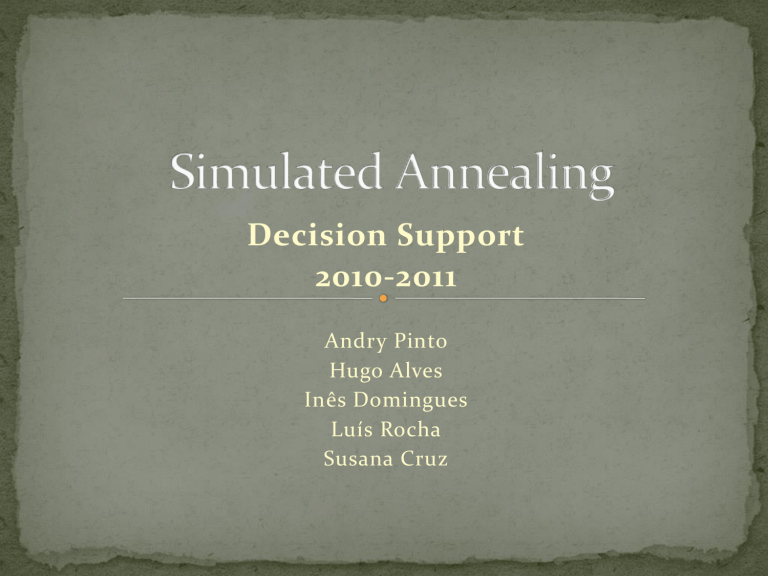
Decision Support
2010-2011
Andry Pinto
Hugo Alves
Inês Domingues
Luís Rocha
Susana Cruz
Introduction to Simulated Annealing (SA)
Meta-Heuristic Concept
Historical Approach
SA Algorithm
Simulated Annealing for the Bin Packing Problem (BPP)
Two Variants of the BPP
Neighborhoods
Parameterization
Computational Results
General methods to be potentially applied to any optimization problem
Contrast with exact and heavy computation algorithms
Find acceptable solutions in admissible amount of time and resources even in real and complex problems
Avoid local minimums by allowing the increase of the cost function under certain conditions
Resemblance to local search methods
Combine multiple heuristics
In condensed matter physics, the annealing is the following process:
A solid is heated in a hot bath, increasing the temperature up to a maximum value. At this temperature, all material is in liquid state and the particles arrange themselves randomly
As the temperature of the hot bath is cooled gradually, all the particles of this structure will be arranged in the state of lower energy
Algorithm:
Metropolis et al. (1953), Equation of state calculations by fast computing machines,
Journal of Chemical Physics , Vol. 21, No. 6
June 1953
Application of these ideas of thermodynamics and metallurgy to optimization problems
Kirkpatrick et al. (1983), Optimization by Simulated
Annealing, Science, Vol. 220, No. 4598, May 1983
Cerny (1985), A Thermodynamical Approach to the
Traveling Salesman Problem: An Efficient Simulation
Algorithm, Journal of optimization theory and
applications, Vol. 45, No. l, January I985
Combinatorial Optimization ⇔ Thermodynamics
Objective function ⇔ Energy level
Admissible solution ⇔ System state
Neighbor solution ⇔ Change of state
Control parameter ⇔ Temperature
Better solution ⇔ Solidification state
‘When optimizing a very large system (i.e. a system with many degrees of freedom), instead of “always” going downhill, try to go downhill “most of the time” ’
(Kirkpatrick, 1983)
Allows to accept worse solutions
A worse neighborhood solution can be accepted depending on:
Temperature
Difference to the best known solution
Initial Solution
Generated using an heuristic
Chosen at random
Neighborhood
Generated randomly
Mutating the current solution
Acceptance
Neighbor has lower cost value
Neighbor has higher cost value is accepted with the probability p
Stopping Criteria
Maximum CPU time
Solution with a lower value than threshold
Maximum number of iterations without improvement
Maximum total number of iterations
Geometric cooling: TL+1= β TL
L - Step with in iterations number
T0 – initial temperature (usually high)
β – cooling parameter (usually between 0.8 and 0,99)
ΔC – Difference between current and previous solutions
Probability of acceptance: p = exp (- ΔC/T) http://www.maxdama.com
Advantages:
Can escape from local minimum
Simplicity
Robustness
Can be improved by other procedures
Problems:
Parameter tuning
Define initial temperature
When and how to decrease the temperature
Can have long computation times
Theory and Methodology
Some experiment with simulated annealing techniques for packing problems
Kathryn A. Dowsland
European Journal of Operational Research 68 (1993)
First Variant (Initial Experiments):
2D BPP with identical pieces
Classical Pallet Loading Problem – Packing identical rectangles into a larger containing rectangle
Feasible Solutions:
The set of feasible solutions can be considered as any placement of the optimal number of pieces in the containing rectangle
Divide pieces and containing rectangle into a checkerboard of unit square
The neighborhood structure:
Is a set of solutions obtained my moving any piece to any other position
Two approaches: including or excluding those positions already occupied
The movements may be restricted to those positions with no overlap and excluding the last piece to be moved
Objective Function:
The main concept is to reduce the overlap between pieces down to the optimal value of zero
Two approaches:
1. Minimize the amount of overlap
2. Minimize the number of overlapping pieces
The Cooling Schedule:
f – cooling schedule
b – iteration step
rep – number of iterations
t – temperature parameter
The Cooling Schedule - determining temperature:
Cooling function:
Heating function:
Relation: considered value k=100
Probability Function:
Usual approach (unsatisfactory):
Proposed alternatives:
Add constant γ
Use linear function
The Sampling Process
Uniform Random Selection – better solution
Cyclic Sampling Pattern
Starting Solution
Random Solution
Solution from a Fast Heuristic
Optimization Step
Rotate 90º
Computational Experiments
100 problems from each of the ranges 5-10, 11-20 and 20-30 pieces fitted
Comparison of 8 methods
The annealing process is very successful when 20 or less pieces are to be fitted
Less reliable when 20 to 30 pieces are to be fitted
The schedule with heating up incorporated appeared to be the best with the fixed α:β ratio
Second Variant:
2D BPP with non-identical pieces
Feasible Solutions
Each piece is a valid combination of the lengths or widths of the other pieces types from the container edge
Neighborhood Structure
Move the position of one of the pieces
Restriction: move only overlapping pieces
Restriction: the last piece is not allowed to move
Objective Function
Minimize the total pairwise overlap weighted according to piece size
Two stages optimization:
Minimize overcover (relaxation of the original problem)
Minimize overlap, constraining overcover to remain zero
Difficult to solve when space is tight
Cooling Schedule
Same as identical pieces case
Probability Function
Sampling Process
Random solution
Starting Solution
Generate random position for each piece
Optimization Steps
Swap two pieces that are overlapping
Computational Experiments
20 problems
5 sets of piece dimensions packed into 4 different widths
Annealing in parallel produced the most promising results
Conclusions
Use of a cooling schedule which also heats up when moves are not accepted
Use of a relaxed objective either in a two stage approach or in parallel
Capability to produce “near” solutions - transformed into solutions by hand

